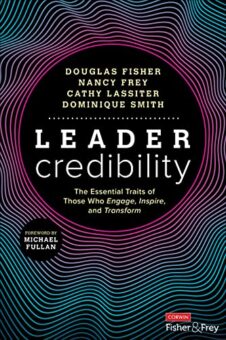Leadership Traits That Engage and Transform
Leader Credibility: The Essential Traits of Those Who Engage, Inspire, and Transform
By Douglas Fisher, Nancy Frey, Cathy Lassiter and Dominique Smith
(Corwin/Sage Publishers, 2022 – Learn more)
Reviewed by Jeny Randall

I’ve benefited greatly from reading this insightful book. And as I read, many of the seasoned leaders with whom I’ve worked came to mind as both exemplars of specific traits and humans with opportunities for growth. Whether you are moving into a leadership role or have been in a leadership position for years, Leader Credibility is a worthy read.
Focusing on essential traits

I found the book both inspiring and practical. Each chapter begins with a self-assessment and reflection tool that allows readers to engage deeply with the forthcoming discussion. The authors discuss the research behind each trait before diving into specific aspects.
Research and anecdotes
Anecdotes throughout the book assist readers in envisioning the trait in action or identifying the absence of a trait. In the latter case, the anecdote serves as an opportunity to practice coaching. Each chapter ends with a table of what the trait is and isn’t (see Leadership practices that convey and derail trust, p.31) and specific, actionable steps to build leadership skills such as “practices to strengthen trustworthiness.”
In addition to research in educational instruction and leadership, the authors draw on expertise from business leadership (Forbes, Harvard Business Review), human behavior, and psychology, among other disciplines. The result is a highly credible resource.
That doesn’t mean it’s dry. As one might expect from authors who are leaders in teacher clarity, Leader Credibility is also concise, well-written, and engaging. “Pause and ponder” boxes are among some of the opportunities for readers to interact with the text.
For new and established leaders alike
Educational leaders of every guise will benefit from this book. In the discussion of each trait, the authors explore skills such as conflict management, feedback, and active listening. Even as someone who has been aware of, practiced and taught active listening, I found new ideas and strategies to strengthen my own leadership skills in this area.
In addition, specific discussions such as “Building Trust When You’re the New Principal” and “Competence and the Challenge of the Internal Appointment” will be of particular interest to some. Each also holds broader relevance. For example, in the discussion of building trust, the authors identify the stages of trust, an idea that is applicable to those building, re-building, or maintaining trust: in short, all of us.
I found the authors’ thoughts and research on an open-door policy particularly intriguing. In their chapter on Immediacy: Verbal and Nonverbal Indicators of Relatedness, the authors suggest that leaders “take a more proactive approach and develop systems to engage with each person who [reports to us] on a regular basis.” (p. 93)
One strategy they offer is “rounding,” familiar to some as the medical practice in which a team visits each patient to discuss their status and make decisions about their care. In an educational setting, leaders “visit teachers and staff members…looking to recognize what is working and improve things that are not” (p. 92). Scheduling rounds is an immediate step I can take that will help me stay informed and increase the feedback I offer, my classroom observations, and visibility.
Making time to develop a vision
The book closes with a fifth characteristic that people look for in leaders: vision. In the final chapter, Forward Thinking to be Future Ready, the authors explore the importance of being “able to answer the question ‘where are we going?’” (p. 101) The chapter includes a summary of research on which activities occupy school leaders’ time, a time analysis tool, and strategies for moving away from what school leader Mark Minkus calls “the tyranny of the urgent” to create time for future thinking.
With sixteen specific, actionable steps and many more embedded within the text, the authors model strong coaching by suggesting readers choose one or two areas to improve.
I’ll be scheduling rounds and time for forward-thinking into my weekly calendar. And when they have become part of my regular leadership practice, I’ll be coming back to Leader Credibility for new growth opportunities.
Jeny Randall is the Middle School Director and language arts teacher at Saratoga Independent School in New York State. She also oversees the curriculum and program development for grades 6-8. Jeny is also a Responsive Classroom certified teacher. Outside of school, she teaches yoga, reads whatever students send her way, and spends time with her family, out of doors if possible!




































